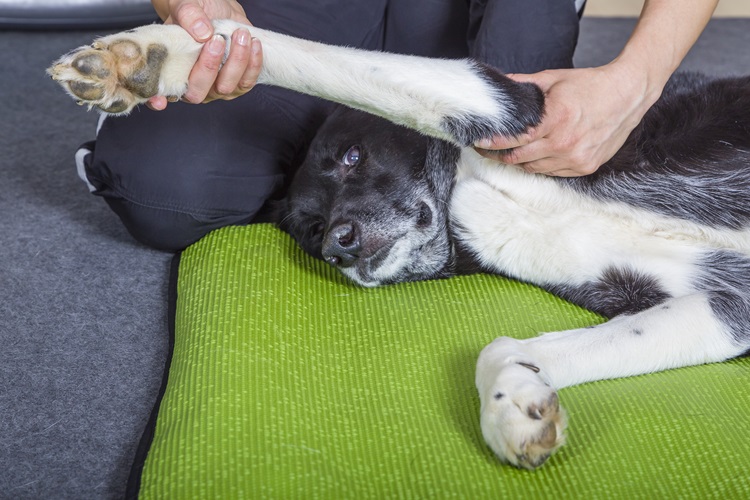How To Recognise If Your Dog Needs Physiotherapy
 Just like humans, dogs can suffer from musculoskeletal issues, injuries and age-related conditions that may benefit greatly from physiotherapy. Learning how to recognise if your dog needs physiotherapy early on can help your furry companion stay active, healthy, and pain-free. Here are some key indicators that your dog might need physiotherapy:
Just like humans, dogs can suffer from musculoskeletal issues, injuries and age-related conditions that may benefit greatly from physiotherapy. Learning how to recognise if your dog needs physiotherapy early on can help your furry companion stay active, healthy, and pain-free. Here are some key indicators that your dog might need physiotherapy:
Changes in Mobility
- Limping or lameness: If your dog is favouring one leg or walking unevenly, it could indicate pain or injury. This may stem from conditions like arthritis, soft tissue injuries, or even minor sprains. Consistently favouring a leg warrants a professional evaluation.
- Stiffness: Difficulty getting up from lying down or showing stiffness after exercise may point to joint or muscular issues. This is especially common in older dogs or those with a history of overexertion.
- Reluctance to move: Hesitation to climb stairs, jump, or engage in normal activities might signal discomfort. Sometimes, dogs may avoid certain movements entirely due to underlying pain or weakness.
Altered Gait
Watch for changes in how your dog walks or runs. If their stride looks awkward or unbalanced, they may have underlying issues that need addressing. For instance, a shorter stride or dragging of paws can indicate neurological problems or muscle weakness. Even subtle changes in gait can be an early warning sign of bigger issues.
Visible pain or discomfort
Dogs are masters at hiding pain, but some signs can be telling:
- Whining, whimpering, or yelping when moving: These vocalisations often occur when a specific action triggers pain.
- Excessive licking or chewing at a particular joint or limb: This behaviour may be their way of trying to soothe an uncomfortable area.
- Restlessness or difficulty finding a comfortable position: If your dog is constantly shifting or seems unable to settle, it could be due to underlying discomfort.
Post injury recovery
If your dog has suffered an injury such as a sprain, fracture, or ligament tear, physiotherapy can be crucial for a complete recovery. It can help restore mobility, reduce pain, and prevent secondary issues like muscle atrophy or compensatory injuries in other limbs. Early intervention can make a significant difference in the healing process.
Post Surgery Rehabilitation
After orthopedic surgeries (like cruciate ligament repairs or hip replacements), physiotherapy supports healing, reduces scar tissue formation, and strengthens muscles. A structured rehabilitation plan can also minimise the risk of complications and improve long term outcomes, ensuring your dog regains full functionality.
Age related changes
Senior dogs often experience:
- Arthritis or degenerative joint disease
- Muscle wasting or weakness
- Difficulty maintaining balance
Physiotherapy can improve their quality of life by easing pain and enhancing mobility. Tailored exercises and treatments can also help slow the progression of age-related conditions.
Weight management issues
Overweight dogs can develop joint and mobility problems. Physiotherapy, combined with a tailored exercise plan, can help them regain a healthy weight while protecting their joints. Additionally. Physiotherapy can improve their endurance and muscle tone, making it easier for them to stay active.
Neurological problems
Conditions like intervertebral disc disease (IVDD) or nerve injuries can result in partial paralysis or weakness. Physiotherapy aids in nerve stimulation and muscle rebuilding. Techniques like proprioceptive training, balance exercises, and hydrotherapy can be highly effective in helping dogs regain control over their movements.
Performance dogs and athletes
Active dogs involved in sports like agility, flyball, or herding may benefit from regular physiotherpay to prevent injuries, maintain peak performance, and recover from intense activities. A physiotherapist can design sport-specific conditioning programs to enhance strength, flexibility, and endurance while minimising the risk of overuse injuries.
What can a dog physiotherapist do?
A certified dog physiotherapist can offer various treatments, including:
- Manual therapy: massages, joint mobilisations, and stretching to improve flexibility and reduce pain. These techniques help release muscle tension and improve circulation.
- Therapeutic exercises: customised routines to strengthen muscles and improve coordination. These exercises are tailored to your dog’s specific needs, focusing on areas of weakness or instability.
- Hydrotherapy: water-based exercises to enhance strength and mobility without putting stress on joints. The buoyancy of water supports the body, making it an excellent option for dogs with arthritis or post-surgical recovery.
- Laser Therapy and Ultrasound: Noninvasive treatments to reduce inflammation and promote healing. These modalities can accelerate tissue repair and provide pain relief for chronic conditions.
When in doubt, consult your vet
If you’ve noticed any of these signs, consult your veterinarian first. They can rule out other medical conditions and, if appropriate, refer you to a qualified dog physiotherapist. Early intervention is key to preventing more serious problems and ensuring your dog’s long-term well-being.
Your dog relies on you to notice when something isn’t right. By recognising early signs of discomfort or reduced mobility, you can seek the help they need to stay happy and healthy. Physiotherapy isn’t just for recovery- it’s also a proactive way to enhance your dog’s overall quality of life. If you’re unsure whether your dog might benefit from physiotherapy, don’t hesitate to ask a professional for guidance.
At WitsEnd, all our physiotherapy is carried out by Shahad (Dr Shahad Mohammed) who has over 20 years’ experience in doing physiotherapy and hydrotherapy. Shahad is a member of NAVP, AHPR and RAMP and he carries full professional insurance.